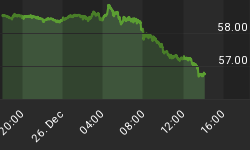A Review of the Past Week
The sharp decline which took place last week came to an abrupt halt. By Friday, most indexes were little changed for the week. This suggests that the cycle mentioned in the last letter is coming to a low point and getting ready to turn up. This process is illustrated very graphically on the chart of the SPX which appears below.
The continued rise in the price of oil appeared to have been the primary concern of investors. It closed the week on its high at $46.60 fueled by concerns over the Venezuelan referendum and its potential to disrupt supplies. Barring some strong negatives over the week-end, I believe that oil may be ready to correct quickly from this level. As Clif Droke pointed out in a recent article, by the time everyone talks about it -- and the media has certainly covered oil ad nauseam recently --the worst is over and prices should pull back. There are good technical reasons, as well, why this should happen.
The stock market position remains unchanged from last week.
Current position of the Market.
Intermediate trend:
SPX - Sell. A confirmed sell was given on 3/10 and re-confirmed after prices failed to penetrate the former highs.
Short term trend:
SPX - Preliminary buy signal.
Note: If you would like to receive an explanation of how I arrive at these signals and be notified on the day that they occur, please let me know at andre@marketurningpoints.com The explanation has been enhanced by the outlining of a strategy based on the signals. Once on the list, you will also receive periodical "Closing Comments".
CYCLES: Let's follow the progress of the cycle mentioned last week. As previously stated, the half-span of the 9 month cycle has a range of 18-22 weeks and it is currently in its 21st week. The graph that follows is an hourly chart of the SPX which illustrates the impact of the cycle on the stock market since the recent short-term high. You can see the decelerating process taking place as the cycle bottoms. This is what oscillators pick-up by showing positive divergence and this is really obvious in the RSI. At the same time, the Stochastics is oversold. From an oscillator view point, you do not get more bullish readings than that at the end of a decline. It is important to note that the daily oscillator readings are also turning bullish.
A trend line drawing technique that often works well to identify the prevailing pattern is that of connecting the tops and bottoms of each short term wave, thus creating an envelope around prices which delineates the cyclic action and helps to identify the low point. You can see how well this works in this case; when looking at this picture, the only logical conclusion is that the cycle looks ready to turn up and generate a short term rally.

What's next?
Since we have pretty much covered what's next for the stock market in the above segment, and since oil appears to be having such a huge psychological impact on investors currently, let's take a look at what's in store for that commodity.
We are going analyze two charts. The first one is a daily chart with traditional momentum oscillators, and the second, a Point and Figure chart.


On the bar chart, it is clear that prices have gone parabolic and created a very overbought condition. In fact, the Stochastics has been overbought for over a month! The MACD is also overbought, but is still moving up, meaning that the momentum is continuing. The only sign of a loss of momentum appears in the MACD histogram which has begun to go sideways.
A Point and Figure chart is a great help in determining how far prices are likely to go before they turn. I have marked the base pattern that had been formed at the beginning of each phase, and the price target generated by each base. As you can see, the accuracy of the "count" can be uncanny, especially in commodities and in equities that are primarily traded by professionals. From this analysis, we can conclude that oil should be at a temporary top, but could still have a little further to go after a pull-back.
This conclusion is reinforced by looking at a third chart, that of the XOI which shows the relative weakness of the stock index versus the commodity. This negative divergence is bearish for oil, and also suggests that it is ready to correct.

SUMMARY: The continued rise in oil prices has been the bane of equities for the past few weeks. However, there is ample evidence that oil is peaking, at least temporarily, and that stocks are ready for a rally. Because of the basing pattern in stocks over the past week, it should be possible to make valid projections for the extent of the move after it has begun.
In spite of the bullish readings, it is important to note that the trend has not yet turned up. The criteria necessary to generate a "Buy" signal will be emailed to the readers on our alert list over the week-end.
The intermediate term trend remains a "Sell" which is expected to continue into September/October.
















